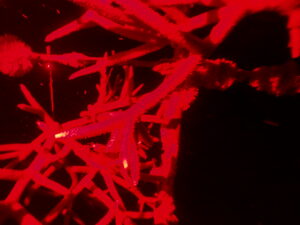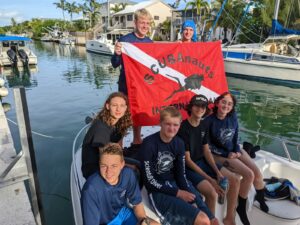This week, 6 other SCUBAnauts and I departed to Mote Marine Laboratory in Summerland Key, Florida. Mote requested SCUBAnauts to help record first time data on the spawning of outplanted Staghorn Coral (Acropora cervicornis).
Mote Marine Lab uses one form of coral reproduction to help restore the coral reefs. This is by breaking the staghorn corals into many pieces as they will all grow into their own coral colonies. This speeds up the growth process of the corals and allows them to reach maturity in order to naturally spawn their own corals, as their other form of reproduction, after Mote Marine has planted the colonies on the reef. These corals only spawn for a week after the first full moon in August, which makes timing a very important factor. Though these corals were outplanted in 2018, this is the first time that Mote Marine has been able to record the spawning of these outplanted corals.
Sunset Cruise
Since the corals will only spawn after sunset, we are out in the water late at night. We left in our boat from Mote Marine Lab about 30 minutes before sunset so we could make it to our dive site and set up before it got too dark. Around 8:30 pm we splashed into the water with our dive gear on and data sheets in hand. Before we dive, each SCUBAnaut is assigned specific colonies that are labeled with yellow numbered tags. These assignments are the corals we spend our time observing during our dives.
Corals begin their spawning process by doing what we call “setting” which is moving the gamete bundles to the surface of each polyp. The setting process can start anywhere from immediately after sunset to late at night, and it is not guaranteed that they will even set. After we were each assigned corals in the water we waited and sang songs to ourselves while we checked the status of the coral spawning. When the coral spawn is based on the moon, which means we are only able to use red light as to not accidentally trick the coral into thinking the sun is out by using a normal white dive light.

Divers can only use red light to observe corals spawning. White light is thought to disrupt the signaling that allows them to spawn at the same time.
Once we notice our corals are set, we record the time and head back to the boat one-by-one to change tanks and get back in the water. In order to make sure that we do not miss the spawning, we make sure before each surveyor ascends there is someone else to watch the corals while they are gone. After about an hour after the corals set, they start releasing the bundles into the water for about ten to fifteen minutes, but can go longer.
On our data sheet we also record the percentage of the coral colony we think actually spawned to get a sense of how productive the spawn is. During the week different corals will have “peak nights” where there is a higher percentage of spawning throughout the reef. We hope for a synchronized spawn each night to help the chances of more DNA types, though it doesn’t always happen.
That’s a Wrap
Around midnight we are all back in the boat headed back home to shower, discuss spawning, and sleep. Despite being tedious at times as we are in the water for 3-4 hours each night watching coral, it is a spectacular event to witness and be a part of. Corals take years and years to grow, so being present for the potential of a new generation that could protect the reefs for decades is truly a wonderful and heartwarming thing to experience. This week has been a great time filled with lots of diving, jokes, food, naps, and coral. This is a wonderful trip that I am very happy to be able to be a part of and I would recommend anyone who has the opportunity to do a trip like this, or at least watch a coral spawn event, to do it.
— Evana F., 1st Class Naut, Tarpon Springs Chapter


